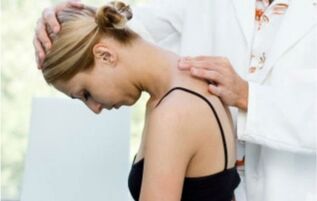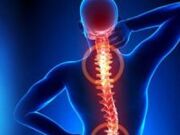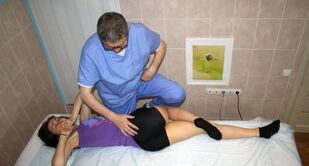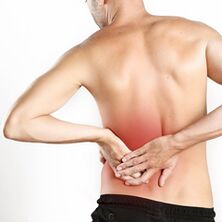It is easier to prevent osteochondrosis than to treat it for a long time. Prevention includes adherence to posture, physical exercise, fitness equipment, athletic walking, yoga, swimming. It is necessary to sit correctly at the table and the computer, you cannot throw your head back for a long time or bend over when lifting weights. When writing or reading, it is not recommended to bend over the table surface and it is advisable to use an orthopedic pillow while sleeping.
Osteochondrosis manifests itself with unpleasant symptoms. Patients complain of back pain, body pain and numbness in their arms or legs for no reason. In some cases, even loss of consciousness or frequent dizziness is possible. If the disease is not treated, it gradually leads to muscle tissue atrophy, decreased nerve impulses and dysfunction of various internal organs.
The causes of the disease are hidden in a passive lifestyle, lack of sufficient load on the spine and developed muscular structure. Concomitant factors are also unhealthy diet, hormonal disorders, posture problems, insufficient fluid intake, hereditary predisposition, infection, obesity and bad habits.
The treatment of osteochondrosis at home is possible if the patient does not use folk remedies as the only therapy and consult a doctor about the complex effect on the pathology. The main ways to get rid of the problem are:
- Medical therapy.
- Massage and physiotherapy.
- Gymnastics.
- Traditional medicine.
It is impossible to cure osteochondrosis quickly, as the affected cartilage tissue regenerates slowly. It will take at least three months to complete complex measures, and it will take about a year for the rehabilitation period. The result obtained with the treatment depends largely on the patient himself, on his commitment to observing the prescriptions, as well as on the stage of the disease's evolution.

Do you know why your spine is suffering? It is almost impossible to say with certainty that the development of the disease started due to inadequate nutrition or stagnation of the blood, therefore, for an effective therapy, an entire program is necessary to restore blood flow to the damaged discs.
In addition, we will talk briefly about methods of treating osteochondrosis at home. We have already talked about some of them in more detail: next, in the method descriptions, see the articles in the links.
- Diet. Often, the cause of osteochondrosis is impaired blood flow due to the accumulation of cholesterol and loss of vascular elasticity. Eliminating fatty foods from the diet, as well as foods high in cholesterol: chicken eggs, meat broths, pork and chicken skins, will help to correct the situation. Strong drinks can play an important role in blood vessel activity, and even those that do not contain alcohol - ordinary coffee and tea. Regular intake of nicotine in the body also leads to vasospasm. The decision is unambiguous: if you are being treated for osteochondrosis, you must completely abandon bad habits and lead a healthy lifestyle.
- Restoring blood circulation in the area of the pathological process is the most important condition for treating osteochondrosis at home. There are many ways: from physiotherapy exercises to rubs and compresses, but you have to choose several and act.
- Orthopedic sleeping supplies. The spine is the axis of the human body, which throughout the day experiences dynamic loads when moving and static when sitting. But, like any other part of the body, it needs adequate rest, which can only be provided by a correct and uniform position during sleep. A quality orthopedic mattress and pillow create the ideal conditions for normal blood circulation during sleep and rest.

Osteochondrosis is a disease that affects the spine, or rather, the intervertebral discs. With its development, the soft elements of the discs are damaged and ossified, and the vertebrae begin to touch, while compressing the blood vessels and nerve fibers located nearby.
Cervical osteochondrosis is one of the most common types of spinal injuries that can occur both in the elderly and in people around 20 years of age.
In the disease development process, specialists distinguish 4 stages:
- Stage I. In this phase, there is a displacement of the intervertebral discs, violating their stability. In that case, the person may experience muscle tension in the affected area and mild pain. Due to mild symptoms, as a rule, this phase is almost imperceptible.
- Stage II. The destruction of the fibrous ring begins, the distance between the vertebrae decreases. Symptoms are pain that is localized at certain points and aggravated by bending or turning the head. Also at this stage, increased fatigue may occur.
- Stage III. The fibrous ring is completely destroyed, a hernia is formed. In this case, the spine is deformed, the pain is much stronger. To reduce discomfort, the person is forced to restrict movement. The obvious signs are frequent dizziness, fatigue.
- Stage IV. This stage is characterized by complete immobility of the injured area of the spine. Periodically, the pain may disappear, but later it will necessarily return, increasing several times.
The sooner cervical osteochondrosis begins, the stronger the possible complications can be. If the disease occurs at a young age, the following consequences are possible:
- herniated intervertebral disc;
- radiculopathy of cervical roots;
- intervertebral protrusion in the cervical region (protrusion);
- vertebral neck pain, etc.
In addition, in the case of advanced osteochondrosis, problems with the vertebral arteries, the development of paresis and other concomitant diseases are possible.
The main symptom of osteochondrosis is back pain. There may also be a sensation of numbness in the limbs. The pain can get worse with movement. Patients may also complain of headache, dizziness, pain in Organs internal organs.
First signs
Cervical osteochondrosis at the onset of the disease may not even appear. The disease is already felt neglected, with frequent head and neck pain when moving. When there is a violation of cerebral circulation in cervical osteochondrosis, a person develops the following symptoms:
- regular headaches;
- violation of sensitivity of facial muscles;
- increased fatigue;
- noise in the head;
- ringing in the ears;
- high blood pressure;
- loss of coordination;
- frequent dizziness;
- wobbly march.
If osteochondrosis of the cervical vertebrae takes on a chronic form, the pain is permanent and any movement of the head is difficult due to the tension in the neck muscles. The patient begins to suffer from cervical migraines and the headache is sometimes accompanied by vomiting, nausea and even loss of consciousness. If cervical osteochondrosis is not treated in time, the person may experience pharyngeal symptoms: difficulty swallowing, feeling dry, itchy and tickling. Over time, this disease can cause herniated discs.
Because the intervertebral discs in the cervical spine are not too high, even slight damage to them causes the disease to develop. The beginning of the problems can be indicated by:
- hoarseness, hoarseness;
- increased dental problems (you need to go to the dentist more often than normal, for example, due to partial tooth decay);
- blurred vision;
- burning sensation between the shoulder blades;
- sore throat as in the throat;
- pain in the shoulder, occipital region, along the entire length of the arms;
- weakness of the forelimbs;
- lack of coordination, expressed in an irregular gait;
- frequent dizziness, which can result in fainting;
- decreased resistance;
- feeling tired immediately after sleeping;
- recurrent headaches on the left side of the chest, radiating to the arm;
- limitation of neck mobility, crushing when turning and tilting.
Experts distinguish between several types of syndromes characteristic of cervical osteochondrosis, including:
- Spine. It develops as a result of a pinched nerve. In this case, the person feels a sharp pain that spreads from the neck to the shoulders, then to the forearms and so on, down to the fingers (or one of the hands). In addition, the root syndrome is characterized by tingling or "spots" on the skin, pale skin and slight swelling.
- Vertebral artery syndrome. The main symptom is a headache at the waist. Most of the time, this pain is constant, but in some cases it can be periodic. An increase in pain occurs after increased activity or after a long period in an uncomfortable position. With a simultaneous decrease in immunity, headache can be accompanied by nausea and loss of consciousness. In addition, in this case, problems with hearing, vision and problems with the vestibular apparatus are possible.
- Cervical migraine syndrome. In this case, due to changes in the position of the vertebrae and discs between them, the blood circulation of the brain is disturbed, which is accompanied by ringing in the ears or its congestion, tachycardia, noise in the head, etc.
- Hypertension. It is characterized by an increase in intracranial pressure. The patient is concerned about severe headache attacks, often accompanied by a feeling of nausea.
Often, with an exacerbation of the disease, the patient's body temperature may increase.
How to treat osteochondrosis at home: folk remedies
Chondrosis can be treated at home only after the doctor has prescribed drug treatment. They aim to relieve back pain, eliminate inflammatory processes and restore the mobility of cartilage tissues. After examination and diagnosis, the specialist prescribes the following groups of drugs:
- Anti-inflammatory.
- Painkillers.
- Vasodilators.
- Muscle relaxants.
- Sedatives.
- Multivitamins.
They must be taken in strict accordance with the regulations. Medicines improve the patient's well-being, restore metabolism. Therefore, after a few weeks, the patient already feels much better, but it should not be forgotten that osteochondrosis is a systemic disease and should be treated only comprehensively. Pills alone cannot solve the problem.
The question of how to treat osteochondrosis at home is of increasing concern. It is important to understand that osteochondrosis is an uncommon disease that goes away after taking the pill. Osteochondrosis is primarily changes in the vertebrae and cartilage. To be healed, you need to take a series of actions. The pills listed above must be drunk without fail, but they cannot be dispensed.
Next, we will consider the possibilities of treating osteochondrosis at home. But before using this or that prescription, you need to consult your doctor not to get hurt.
The first thing to do is to relieve the pain. This can be done with drugs. But it is important to understand that the regular use of painkillers can cause problems in the intestines, liver and pancreas. That is why an experienced doctor will certainly advise those folk remedies that can be used safely at home.
- Honey and grated potatoes. Take some potatoes and rub on a fine grater, then mix in equal proportions with the honey. Mix well and place the porridge over gauze, then apply as a compress to the painful spot. Up there, you need to wrap something warm and leave it in this position for an hour. This remedy relieves pain quickly, but unfortunately, not for long.
- Horseradish leaf. Take a horseradish leaf and steam it with boiling water. Turn the sheet inside with you and attach it to the diseased area. Wrap up tight and go to bed. In the morning, you will feel that the pain has subsided.
- Hot bottle. Take a plastic bottle and pour hot water into it, place it on the sofa or bed and lie on your back. Try to curl under you for half an hour.
- Parsley. For a month, you need to eat a parsley root every day.
- Pine buds. Collect pine buds each spring, but only those that are two inches long. Wash them well, dry them and grind them with a meat grinder. Add sugar in a 1: 2 ratio, the number 2 is the kidneys.
- Mix well and remove to infuse for two weeks in the refrigerator. You can understand that the mixture is ready for the color change, it will turn brown. The course of treatment will be three weeks. Eat a teaspoon every day.
- Bath. You can relieve pain in thoracic osteochondrosis in a steam room. The course of treatment is ten days. Do three five-minute runs. But visit the bath every day.
Massage and healing baths

- Start the process with a light and gentle touch on the problem area. It is best not to carry additional devices, the impact of the palms and fingers will be sufficient.
- After rubbing, they increase the effect on the area. You can take a fold of the skin with your fingers and squeeze lightly.
- The kneading of muscles and soft tissues must occur in the paravertebral region, being impossible to influence the crest itself. The movement can be hitting, circular, pressing.
- To end the session, it is worth touching, vibrating, caressing.
This back massage can be performed every day, even without special knowledge and skills. The impact on the muscles of the chest, hips, shoulders, lower back, has a beneficial effect in the treatment of osteochondrosis in general.
In addition to massage, therapeutic baths help to deal with the disease. They are contraindicated during the period of exacerbation, but they become indispensable in the remission phase. Correct and regular exercise allows you to increase blood flow, relax your muscles, improve your mood and well-being. Only warm water can be used in the process (hot water is only bad), to which decoctions of medicinal herbs are added. Thyme, string, thyme, lemon balm, chamomile proved to be good. Take a medical bath 20 minutes before bedtime.
Simple exercises are useful for the spine with cartilage dysfunction. The doctor selects for each patient individually, taking into account the general condition, physical fitness, age. They are performed daily and are an integral part of therapy. The simplest activities resemble school exercises, but their importance to the body during the treatment period should not be underestimated. They are designed to warm up muscles, improve blood circulation, stretch and relax muscles where there are blockages.

During execution, you should follow these recommendations:
- Don't exercise quickly, putting too much stress on your bones and muscles.
- Everything is done smoothly, thoughtfully, with the control of the sensations in the body.
- Classes are completely interrupted if the patient feels pain and is unable to straighten up.
- Strength complexes always alternate with breathing exercises so that the tissues receive a sufficient amount of oxygen.
- Classes should only be taught in a well-ventilated room or outdoors.
It should be remembered that the attending physician prescribes exercise, some effects on the spine are dangerous in the event of a disease such as osteoporosis. They can cause serious complications. Exercise therapy is an excellent tool to combat pathologies in the back and is often used to prevent a range of problems with increased risks. The complexes include yoga exercises or oriental techniques. You need to do this regularly, at least 3 times a week.
Physiotherapy for osteochondrosis is used as a complement to the main treatment, the patient's condition becomes noticeably better. Physiotherapy procedures work directly on the painful focus, so that no side effects will arise.
- The body's metabolism is normalizing.
- The condition of tissues and organs is improving.
- Immunity increases and becomes more resistant.
- Pain is relieved.
- Good anti-inflammatory and anti-edema effect.
Experts usually prescribe combined physical therapy. For example, if the pain is severe, electrophoresis and diadynamic therapy are used, with mandatory use of novocaine.
In order to simultaneously affect biologically active points, acupuncture-reflexolaser-puncture is used. The tissue is influenced by laser radiation and needles. Along with electrotherapy, mud therapy is used.
Massage
- During the period when there is no pain, at that moment, the movements will not cause pain.
- At the time of exacerbation.
Before the specialist starts this procedure, the patient is prepared. To do this, you need to caress your back for about 3-5 minutes, first caressing the shoulder blade area, then closer to the neck and shoulder girdle. After that, stroking should be replaced by kneading and shaking. At this stage, the preparation will be completed and you can proceed directly to the massage procedure.

Massage for osteochondrosis can cause severe pain. But if the body is properly prepared and relaxed, it can be avoided.
If you feel discomfort after the first few procedures, you need not worry, by the third day the pain will decrease and the procedure itself will be much more pleasant.
The patient should be placed on a flat surface in a horizontal position. If the massage is performed only on the neck, the patient must be seated.
There is another way to treat osteochondrosis with folk remedies - herbal baths. Baths can be used not only for cleaning purposes, but also for healing purposes, choosing the right medicinal herbs and their quantity. Baths, like any alternative osteochondrosis treatment method, should be taken only after consulting the doctor. In some forms of osteochondrosis, they may be contraindicated.
To treat spinal osteochondrosis with baths, you need to know some recipes for its correct preparation:
- Bath with birch leaves. To cook, you need to prepare birch leaves. The bathing procedure should take about half an hour. The water should be slightly warm.
- Chestnut bath. To cook, crush the chestnut and boil for 15 minutes. Then pour into a bathtub and take for about 20 minutes.
- Pine needle bath. It is necessary to collect some needles from the forest trees, boil them for about 20 minutes. Then pour the broth into the tub and take it for about 25 minutes.
- Chamomile bath. It is necessary to pour boiling water over the chamomile and let the broth ferment for half an hour. Then you can filter the drug and take a shower.
- Jerusalem artichoke bath. It is necessary to fill a bucket with a capacity of 10 liters of Jerusalem artichoke stalks and leaves, pour boiling water over them, wait 20 minutes. Pour the liquid into a bath. The bath procedure takes 15 minutes.
For a more effective treatment of osteochondrosis of the spine, the duration of treatment should be about one week. Bathing has a relaxing and calming effect, relieves spasms and relieves pain. This homemade treatment is not only beneficial, but also pleasant.
How to cure cervical osteochondrosis at home

There are several reasons for the onset and development of the disease. Among the most common:
- hereditary predisposition;
- posture disorders;
- age;
- previous spinal injuries;
- heavy loads, including heavy physical work and sports;
- previous infectious diseases;
- wear tight, uncomfortable shoes or high heels;
- Unhealthy diet, including excessive reliance on junk food.
In addition, overweight, frequent stress, a sedentary lifestyle and even severe hypothermia can contribute to the occurrence of osteochondrosis.
The cause of osteochondrosis can be hypothermia, a steep slope or curve, intense physical effort.
Experts are sure that the main cause of osteochondrosis is the incorrect distribution of the load on the spine. As a consequence, where there is excessive physical pressure, there is a complete or partial change in the cartilaginous tissue.
- The spine is curved.
- The patient shrinks when sitting or walking.
- The back muscles are weak.
- A person leads a sedentary life, moves little.
- There is a great lack of calcium, magnesium and phosphorus in the body.
- Hereditary factors.
- Previous infectious diseases.
- Severe nervous tension, depression.
- Hormones are disturbed.
- Spinal injuries, can occur during a fall, impact.
- The position of the body changes frequently and abruptly.
If the weights are lifted perpendicular to the trunk, prolapse of the intervertebral disc may occur. Therefore, a large load should be carried only in the squat, thus, the spine will be protected.
The treatment of osteochondrosis of the cervical spine includes a whole range of means and methods that aim to eliminate pain and fight the inflammatory process in the tissues. An effective method is daily exercise for spine flexibility. As a rule, an individual exercise program is selected by a doctor after diagnosis by means of magnetic resonance imaging or computed tomography and assessment of the stage of the disease. Let's look at how cervical spine osteochondrosis is treated.
Drug therapy is prescribed at the first signs of cervical osteochondrosis. If the first pain can be eliminated with a regular anesthetic pill, it will not help later. The medical treatment of cervical osteochondrosis is carried out with new generation chondroprotectors - drugs that stimulate the restoration of the cartilaginous tissue of the spine.
But if you need to relieve acute pain in cervical osteochondrosis, doctors prescribe a blockade of novocaine or non-steroidal anti-inflammatory drugs. They are ointments, capsules, pills and injections that quickly improve the general condition of the patient. But if chondroprotectors have no contraindications even with prolonged use, then NSAIDs have serious contraindications, so their use should be agreed with the attending physician.
To quickly anesthetize the cervical spine with osteochondrosis, special gels or ointments, which start to act 10 minutes after application, help. There are several types of them:
- Regenerating, allowing to restore damaged cartilage tissue between the vertebrae.
- Anti-inflammatory, based on non-steroidal substances, eliminates pain.
- Painkillers that affect nerve endings, quickly reducing pain.
- Massage ointments.
Manual therapy
The oldest method, but no less effective than modern methods of treating osteochondrosis, is manual therapy. Experts have developed many techniques that have a beneficial effect on the vertebrae, tissues and joints in the affected area. Only the chiropractor should be a good specialist in his field, so as not to take the patient to a wheelchair. The main methods of manual therapy for osteochondrosis of the cervical spine are:
- segmental massage that relieves muscle tension;
- manipulations that aim to restore the working capacity of the joints, accompanied by their crushing;
- mobilization, restoring damaged joints, stretching them.































